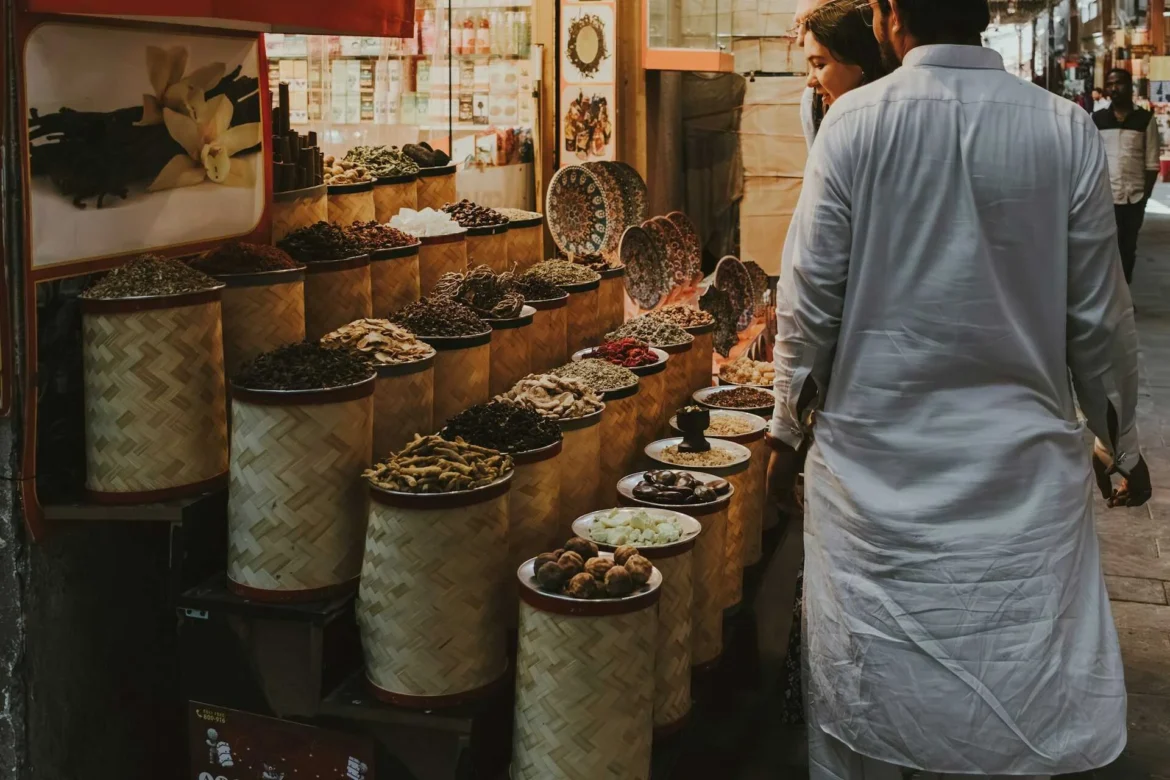When people think of Dubai, the image that often comes to mind is one of futuristic skyscrapers, luxury resorts, and endless shopping malls. Yet, hidden within the city’s modern identity is a world that reflects its heritage, culture, and origins. To truly understand the heart of Dubai, you must step away from the glitz of Downtown and explore the historic charm of Dubai Creek, Old Dubai and Souks.
For those planning Dubai travel for UK tourists, this area offers a unique experience. It is where tradition meets commerce, and where history continues to shape the identity of a global city. In this blog, we will dive deep into the Creek, heritage neighborhoods, and bustling markets, uncovering the cultural essence of Dubai.
Discovering the Story of Dubai Creek
Dubai Creek is more than a waterway. It is the lifeline that first put Dubai on the map. Stretching inland from the Arabian Gulf, the Creek nurtured a community of pearl divers, fishermen, and traders. Long before oil transformed the fortunes of the emirates, this natural harbor connected Dubai to distant lands like India, Persia, and East Africa.
Today, it continues to thrive as a cultural hub. Dhows, or traditional wooden boats, still line its shores, loading and unloading goods. The Creek represents continuity, bridging the Dubai of the past with the modern marvels we see today.
Abra Rides Across the Creek
One of the most authentic experiences is an abra ride across the Creek. For just a small fare, these traditional wooden ferries shuttle passengers between Deira and Bur Dubai. The experience is both practical and atmospheric. As you glide across the water, the air is filled with the sounds of merchants, the call to prayer, and the bustle of nearby souks.
For UK tourists, this is more than a simple boat ride. It is a window into daily life, unchanged for centuries, offering a perspective that skyscrapers cannot provide.
Waterfront Attractions
Alongside the Creek, you will find museums, art galleries, and heritage restaurants. Many offer rooftop views where you can watch dhows pass by while sipping Arabic coffee. It is a tranquil reminder that Dubai’s heritage is as captivating as its futuristic identity.
Old Dubai – The Soul of the City
If the Creek is the lifeblood, then Old Dubai is the soul. This part of the city preserves traditions in a way that allows visitors to step back in time. Narrow alleys, sand-colored buildings, and historic courtyards evoke the Dubai that thrived before modern development.
This area is essential for Dubai travel for UK tourists because it provides balance. Exploring Old Dubai gives context to the rapid transformation the city has undergone.
Al Fahidi Historical District
The Al Fahidi Historical District, often called Al Bastakiya, is one of the most charming heritage neighborhoods. Built in the late 19th century, it features narrow lanes, wind towers, and traditional courtyards. These wind towers were an early form of natural air conditioning, long before modern technology arrived.
Today, the district houses art galleries, artisan shops, and cultural exhibitions. The Dubai Museum, inside Al Fahidi Fort, tells the story of Dubai’s journey from a fishing settlement to a modern city. Visitors can also attend workshops or cultural meals at local centers.
Sheikh Mohammed Centre for Cultural Understanding
One of the highlights in Old Dubai is the Sheikh Mohammed Centre for Cultural Understanding. This institution offers cultural tours, Emirati meals, and sessions where visitors can ask anything about local traditions and religion. For UK travelers, this is a valuable opportunity to gain insights beyond sightseeing.
Souks of Dubai – A Marketplace of Traditions
The souks are where the spirit of Dubai Creek, Old Dubai and Souks comes alive most vibrantly. These traditional markets are not just about shopping. They are immersive cultural experiences filled with color, scent, and sound.
Walking through the souks feels like stepping into a living museum. Merchants call out to customers, spices fill the air, and glittering displays beckon from every direction.
The Gold Souk
Located in Deira, the Gold Souk is one of the most famous markets in the world. With hundreds of shops displaying intricate jewelry, it truly justifies Dubai’s title as the City of Gold. Whether you are buying or browsing, the atmosphere is dazzling.
For UK tourists, the Gold Souk offers more than luxury. It also provides insight into how trade in precious metals helped shape Dubai’s economy. Bargaining is expected, and it adds an interactive dimension to the shopping experience.
The Spice Souk
The Spice Souk is a sensory journey. Brightly colored sacks of saffron, cinnamon, cloves, and cardamom line the walkways. The aromas are irresistible, and shopkeepers are always ready to share knowledge about the spices’ origins and uses.
For UK travelers, the Spice Souk is an excellent place to buy authentic gifts and to learn about Emirati cuisine. It is a reminder of how trade linked Dubai to India, Iran, and other spice-producing regions.
The Textile Souk
In Bur Dubai, the Textile Souk offers fabrics of every kind, from silks to hand-embroidered pieces. The vivid colors and textures reflect Dubai’s role as a hub of global commerce. Tailors nearby can turn your chosen fabric into custom outfits within a day or two, making the experience truly unique.
Beyond Shopping – The Souks as Cultural Hubs
The souks are not just about goods. They represent the city’s history of trade and its cultural diversity. Bargaining with merchants, listening to their stories, and watching daily life unfold are experiences that no shopping mall can replicate.
For UK tourists, this is the kind of authenticity that makes travel unforgettable. The souks represent Dubai’s heritage and the traditions that continue to shape its modern identity.
Culinary Experiences Along Dubai Creek
Food is another way to connect with the culture of Dubai Creek, Old Dubai and Souks. The area offers both traditional street food and refined dining with views of the Creek.
Street Food Adventures
From shawarma and falafel to grilled kebabs, the street food scene is rich and accessible. Local cafeterias and small eateries serve hearty meals that reflect Dubai’s multicultural population. Trying these dishes is one of the most affordable and authentic ways to enjoy the city.
Fine Dining with a View
For those who prefer a more refined experience, there are numerous restaurants overlooking the Creek. Many combine Emirati flavors with international cuisine. Dining with a view of traditional dhows passing by offers a balance of luxury and culture.
Cultural Festivals and Events
The Creek and Old Dubai often come alive with cultural festivals. These events showcase traditional music, dance, and crafts, giving visitors a direct window into Emirati heritage.
During Ramadan, the area becomes particularly special. UK tourists can join communal iftars, where locals and visitors break their fast together. These gatherings are more than meals. They are opportunities to experience the generosity and hospitality of Emirati culture.
Travel Tips for UK Tourists
When planning Dubai travel for UK tourists, exploring the Creek, Old Dubai, and souks requires a little preparation. Here are practical tips to make the most of your visit:
- Visit early in the morning or late in the evening to avoid the heat.
- Dress modestly, especially in heritage areas and souks.
- Bargain politely, as it is part of the shopping culture.
- Use public transport such as the metro and abras for convenience.
- Carry water to stay hydrated in Dubai’s climate.
Suggested Itinerary for a Day in Old Dubai
Here is a sample itinerary to help you explore the best of Dubai Creek, Old Dubai and Souks in one day.
| Time | Activity | Location |
|---|---|---|
| Morning | Abra ride and walk along Dubai Creek | Deira to Bur Dubai |
| Late Morning | Visit Al Fahidi Historical District | Al Fahidi |
| Afternoon | Explore Dubai Museum and cultural lunch | Al Fahidi Fort & Cultural Centre |
| Late Afternoon | Shopping at Spice and Gold Souks | Deira |
| Evening | Dinner overlooking the Creek | Creekside restaurants |
This mix allows you to experience heritage, shopping, and dining all in a single day.
Why UK Tourists Should Explore These Areas
For UK visitors, Dubai travel often centers around beaches, resorts, and modern attractions. But Dubai Creek, Old Dubai and Souks provide a deeper story.
- They showcase authentic Emirati culture.
- They are affordable and accessible.
- They offer interactive experiences like abra rides and bargaining.
- They provide a balance between modern luxury and traditional charm.
These experiences help travelers leave Dubai with a true sense of its history and character.
Plan Your Cultural Journey Today
Exploring Dubai Creek, Old Dubai and Souks is more than a sightseeing activity. It is an opportunity to step into the past, engage with traditions, and experience the authentic spirit of Dubai. For UK tourists, it is the perfect balance to complement modern attractions and luxury resorts.
If you are planning your next trip, add this cultural side of Dubai to your itinerary. Book your flights, plan your stay, and get ready to explore the heritage that shaped one of the world’s most dynamic cities.
FAQs
What is the best time to visit Dubai Creek?
The best time to visit is during the cooler months, from November to March. Evenings are particularly atmospheric with pleasant weather and lively markets.
How much does an abra ride cost at Dubai Creek?
An abra ride typically costs just one dirham, making it one of the most affordable and authentic experiences in Dubai.
Is bargaining common in Dubai’s souks?
Yes, bargaining is expected and considered part of the shopping experience. Tourists should negotiate politely for the best prices.
Are the souks suitable for families with children?
Absolutely. The souks are family-friendly, and children often enjoy the vibrant sights, sounds, and scents.
Can I explore Dubai Creek and Old Dubai in one day?
Yes, it is possible to explore the Creek, Al Fahidi, and several souks in a single day, especially if you plan your itinerary carefully.


